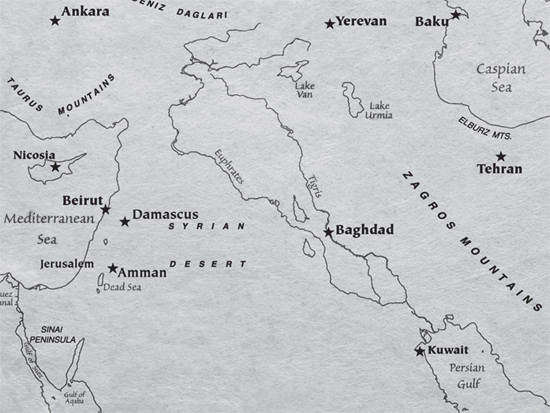The question of the Garden of Eden’s location has captivated theologians and biblical scholars for centuries. Many interpretations point towards the Middle East, specifically near the Tigris and Euphrates Rivers. This view primarily stems from the detailed description provided in the Book of Genesis, chapter 2. But does this traditional understanding hold up to scrutiny, and could there be more to the story than meets the eye?
Biblical Description of Eden’s Rivers
Genesis 2:8-14 offers a seemingly geographical marker for the Garden of Eden:
The Lord God planted a garden eastward in Eden. . . . Now a river went out of Eden to water the garden, and from there it parted and became four riverheads. The name of the first is Pishon . . . . The name of the second river is Gihon. . . . The name of the third river is Hiddekel [Tigris].  ;. . . The fourth river is the Euphrates.
This passage clearly mentions four rivers originating from a single source in Eden, naming the Tigris and Euphrates among them. For many, this has been straightforward evidence placing the Garden of Eden in the region of modern-day Iraq and surrounding areas, where the Tigris and Euphrates rivers flow.
The Traditional Middle East Location and Its Challenges
The notion that the Garden of Eden was situated in the Middle East, near the Tigris and Euphrates, has become a widely accepted interpretation. However, even historical theologians have wrestled with the geographical implications of the Genesis description. John Calvin, a prominent 16th-century theologian, grappled with the specifics in his commentary on Genesis.
Calvin noted:
Moses says that one river flowed to water the garden, which afterwards would divide itself into four heads. It is sufficiently agreed among all, that two of these heads are the Euphrates and the Tigris; for no one disputes that . . . (Hiddekel) is the Tigris. But there is a great controversy respecting the other two.
Calvin recognized the difficulty in reconciling the biblical account with the physical geography. He further observed:
For Moses divides the one river which flowed by the garden into four heads. Yet it appears, that the fountains of the Euphrates and the Tigris were far distant from each other.
This astute observation highlights a crucial point: the Genesis description speaks of a single river dividing into four, whereas the Tigris and Euphrates as we know them today do not originate from a common source. This geographical discrepancy raises questions about the literal interpretation of Eden’s location in the contemporary Middle East.
Noah’s Flood: A Catastrophic Game Changer
 Map
Map
Map of the Middle East highlighting the Tigris and Euphrates Rivers, often associated with the biblical Garden of Eden.
A critical factor often overlooked in discussions about the Garden of Eden’s location is the cataclysmic event of Noah’s Flood. The Bible describes a global flood that drastically reshaped the Earth’s surface. Creationist perspectives emphasize the overwhelming geological impact of this flood, suggesting that much of the sedimentary strata found across the globe is a result of this event.
Considering the magnitude of a global flood, it’s plausible, even probable, that the pre-Flood geography was radically altered. The landscape described in Genesis 2, including the original river system of Eden, would have been submerged and transformed by such a catastrophe. Beneath the region of the modern Tigris and Euphrates rivers, there are indeed significant layers of sedimentary rock, many containing fossils.
This geological reality presents a profound challenge to placing the Garden of Eden in the present-day Middle East. The presence of fossil-bearing strata indicates a region that was subjected to catastrophic events and, crucially, contains evidence of death on a massive scale. The concept of a perfect, unspoiled Garden of Eden existing atop layers of fossils—remnants of a post-Fall world—introduces a theological and geological incongruity. The Garden of Eden was a place untouched by sin and death, a state that seems incompatible with a location resting upon Flood sediments filled with fossils.
Re-evaluating the Tigris and Euphrates Names
If the Garden of Eden wasn’t located where the modern Tigris and Euphrates flow, why are these river names mentioned in Genesis 2 and present in the Middle East today? The answer may lie in the post-Flood repopulation and renaming of the Earth.
Throughout history, it’s common for settlers and explorers to name new locations after familiar places from their homelands. For example, Australia has numerous place names mirroring those in England, such as Newcastle. Similarly, the United States features rivers like the Thames in Connecticut and the Severn in Maryland, named after UK rivers.
Following the Flood, Noah and his family, carrying the memory of the pre-Flood world, emerged from the Ark in the region of the Ararat mountains – geographically within the Middle East. It’s highly plausible that as they repopulated and explored the post-Flood world, they used familiar names, including those of the pre-Flood rivers of Eden, to designate new geographical features. The Tigris and Euphrates rivers of today could therefore be named in remembrance of the original rivers of Eden, not necessarily marking the exact original location.
Conclusion
Ultimately, pinpointing the precise geographical location of the Garden of Eden remains elusive. While the Bible provides clues, the overwhelming geological impact of Noah’s Flood significantly complicates any attempt to place Eden definitively on a modern map. To insist that the Garden of Eden was situated in the area of the present-day Tigris and Euphrates Rivers disregards the transformative effects of the global Flood and potentially implies the presence of death before the biblical Fall and the introduction of sin into the world. The true location of the Garden of Eden, paradise lost, may well remain a mystery hidden beneath layers of history and geological upheaval, awaiting a future revelation.
